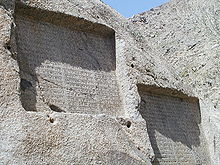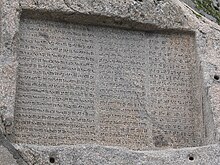Gandschnāme
Gandschnāme (also Gandj Nameh or Ganj Nāme , Persian گنجنامه Ganj Nameh , 'Treasure Book' orجنگنامه Dschangnāme , 'war book' or Dschang Nameh , also Djang Nameh and Jang nameh ) is the name for two cuneiform tablets from the Achaemenid period , whichare carvedinto a rock of the Alvand Mountains, near Hamadan ( Iran ).
Place of the inscriptions
Gandschnāme is located 12 km southwest of the center of Hamadan , 5 km from the outskirts, in the upper area of a popular local recreation area of Hamadan, the Abbas Abad Valley. There is also a waterfall and the valley station of a mountain railway near the inscriptions. The left of the two inscriptions refers to Darius I (549 - 486 BC), the right to Xerxes I (519 - 465 BC). At the time of the Achaemenids, the old Median Ekbatana , today's Hamadan, was the summer residence of the monarchs, and Gandschnāme was therefore on the northern branch of the ancient Persian royal road to Mesopotamia.
Other, older names for the location of the inscriptions are Sang Nebeschte, Nebescht-e Chodayan, Dahmehan, Tabanar, Katibe-ha-ye Alvand. A plaque in New Persian gives the word Ganj ( Persian گنج Gangsch , 'treasure') and his palindrome Jang ( Persian جنگ Dschang , 'war') from the idea of the people the interpretation of treasure through wars of kings .
Discovery story
When the cuneiform texts could no longer be read by Gandschnāme, they were named after assumptions that the inscriptions contained a reference to a hidden treasure (treasure book) or were intended to remind of a war (war book). Their rediscovery for posterity began with Eugène Flandin , who traveled to Iran with Pascal Coste in the first half of the 19th century and sketched this mountain gorge of the Elvand Mountains. He noted that there are cuneiform inscription fields here. Henry Rawlinson, who contributed decisively to the deciphering of the cuneiform script, knew and used these inscriptions. In his opinion, they were drawn up on the occasion of one of the journeys each of the two monarchs made annually between Ekbatana and Babylon.
Text analysis
As is customary with the Achaemenid inscriptions since Darius I, the tablets are written in three languages. The left of the three 20-line text blocks in Old Persian written, then follows in the middle neuelamische and right the Neo-Babylonian text version.
The old Persian cuneiform is the youngest of the three writing systems and manages with 34 characters; New Elamite requires around 200 and Neo-Babylonian around 600 characters. Deciphering the ancient Persian inscriptions was therefore the easiest, especially since it is a letter script (read from left to right) and word separators (wedge inclined to the left) were used for better legibility. A look at the extent of the three text blocks of the two inscriptions confirms that a letter font requires more space than a syllabary font.
The old Persian texts are transliterated and translated into Persian and English on information boards of the Organization for Cultural Heritage and Tourism of Hamadan (CHTO) . In the photographic excerpt from the display board for the Xerxes inscription reproduced here, a few places were highlighted: Line 12 contains the name "Xerxes", in lines 7/8 it occurs again in a line break and has an accusative ending, and line 19 contains the name "Darius".
In German the Xerxes inscription reads: “The great God is Ahura Mazda , the greatest of the gods, who created this earth, who created that heaven, who created man, who created joy for man, Xerxes made one king, one of many king, one of many ruler. I am Xerxes, the great king, king of kings, king of the lands of many peoples, king of this great earth also from afar, son of Darius, an Achaemenid. "
The Darius inscription reads: “The great God is Ahura Mazda , who created this earth, who created that heaven, who created man, who created joy for the man who made Darius king, one of many to be king, one of many to be ruler. I am Darius, the great king, king of kings, king of the lands of many peoples, king of this great earth also from afar, son of Hystaspes , an Achaemenid. "
The text of the Xerxes inscription is practically identical to the first half of an inscription that appears three times in Persepolis in the Darius palace - again in three languages. However, compared to these palace texts as well as to the Darius text considered here, it contains an additional predicate from Ahura Mazda : "the greatest of the gods".
literature
- Walther Hinz: Darius and the Persians. A cultural history of the Achaemenids. Holle, Baden-Baden 1976, ISBN 3-87355-165-9 .
- Heidemarie Koch : Persepolis. Shiny capital of the Persian Empire. von Zabern, Mainz 2001, ISBN 3-8053-2813-3 .
- Andrew Robinson: The History of Scripture. Albatros, Düsseldorf 2004, ISBN 3-491-96129-7 .
Web links
Individual evidence
- ↑ Information boards of the Hamadan Cultural Heritage and Tourism Organization (CHTO)
- ↑ NYPL Digital Gallery: image ID 1543017
- ↑ WSW Vaux, Persia , pp. 97-99
- ^ Heidemarie Koch: Persepolis. P. 45/46.




